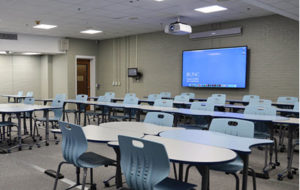Calgary, Alberta — October 27, 2021 — Nureva Inc., an innovator in advanced audio conferencing solutions, announces that the University of North Carolina Hussmann School of Journalism and Media has chosen Nureva® audio for all the learning spaces in the Carrol Hall building, its home on the UNC campus at Chapel Hill. Eighteen Nureva HDL300 systems are deployed in the building with plans to add up to six more. Standardizing on Nureva audio throughout the journalism school allows UNC to provide a consistent and reliable experience for instructors and students. Nureva systems are ideal for hybrid learning as remote students feel like they are in the classroom with their fellow students. They can hear and be a part of every conversation no matter where the instructor or in-class students move in the room or the direction they face. This is made possible by Nureva’s Microphone Mist™ technology, which fills a room with thousands of virtual microphones so there always one nearby.
In addition to clear, reliable audio performance, Nureva received high marks from the Hussman School IT team for ease of installation. Each integrated microphone and speaker bar was installed in about 30 minutes, with no need for an outside technician. Price was another factor. A Nureva HDL300 for mid-size spaces and the Dual HDL300 for large spaces provide true full-room microphone coverage for a fraction of the cost of multicomponent, customized solutions. Instructors like being able to move anywhere in the room and be heard clearly by remote students, without the hassles associated with lavaliere or handheld mics. The success of Nureva audio in the journalism and media school has inspired four other departments at UNC to purchase Nureva systems. UNC has selected Nureva as the audio system of choice for Curtis Hall, a state-of-the art building for media education currently under construction. The showcase building will have up to seven HDL300 systems in key studio and learning spaces.
“What I like best about Nureva audio systems is the simplicity. All I have to do is plug it in, and it works. It just works,” said Gary Kirk, broadcast engineer at UNC’s Hussman School. “Nureva is the perfect choice to fulfill our goal of building classrooms that are collaborative, scalable and affordable.”
“Our relationship with UNC goes back to when they outfitted their first ‘dream classroom’ in 2018, and we are excited by the success they have experienced with our solutions,” said Nancy Knowlton, Nureva’s CEO. “The Hussman School is one of the top journalism and media schools in America, and we are honored to be their provider of choice for audio systems.”
- Chief Releases Fit Mobile Cart for Interactive Displays - May 6, 2024
- Higher Ed Tech Innovation News - April 25, 2024
- How is Technology Used in Higher Education? - April 25, 2024

